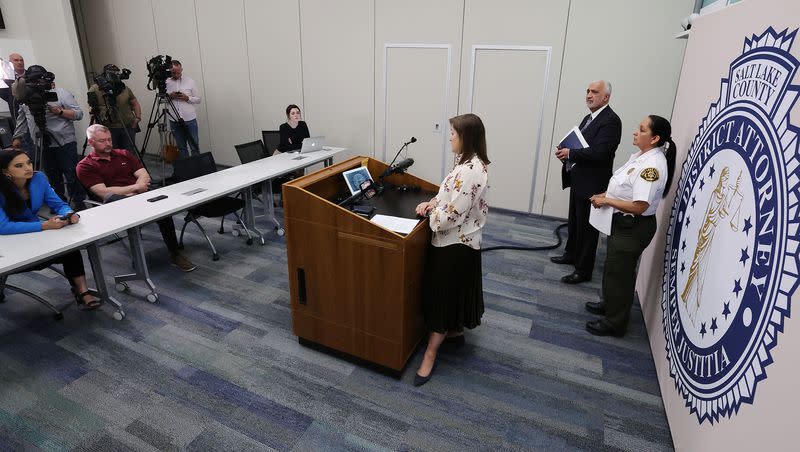Utah has received millions from opioid settlements, but is still waiting on Purdue Pharma

Over the next decade, Utah will see hundreds of millions of dollars funneled into the state through settlements from some of the nation’s largest opioid manufacturers, accused of fueling the addiction crisis that in 2021 killed over 80,000 Americans, according to the National Institutes of Health.
But it’s still unclear exactly how much Utah will get from Purdue Pharma, the infamous pharmaceutical giant whose former president Richard Sackler will be played by Matthew Broderick in an upcoming fictionalized Netflix series “Painkiller.”
Salt Lake County has already received over $6 million in settlement payments from Johnson & Johnson, and distributors McKesson, Cardinal Health and AmerisourceBergen — in total, payments from the three companies will amount to $57 million, and will be distributed over the next 18 years.
Related
How Utah went from one of the country’s highest rates of opioid overdose deaths to one of the lowest
That’s part of the roughly $209 million that will be paid out to Utah.
Announced this June, the most recent settlement comes from drug makers Teva and Allergan, and pharmacies CVS, Walmart and Walgreens — those numbers are not final yet, but Salt Lake County will likely see about $44 million. Utah as a whole will get about $309 million.
Overall, litigation against the pharmaceutical industry has resulted in over $50 billion in settlements for states and individual victims of the opioid crisis.
But the bankruptcy settlement from Purdue Pharma is still pending.
Rich Piatt, a spokesperson for the Utah Attorney General’s Office, said the settlement will likely be less than what Utah got from other companies.
“Purdue is much smaller than any of these other companies, even when it was a concern,” he said.
Piatt said the interest in Purdue Pharma has more to do with the opioid products it created, and the way it marketed them, then its actual market share. So even though the Sackler family had an outsized role in the crisis, their contribution in the form of settlements won’t match that of massive companies like Johnson & Johnson, or Walmart.
What’s unique about the Purdue Pharma settlement is where the money will come from. Unlike other payouts, the Sacklers are expected to personally contribute at least $6 billion to the settlements, according to court documents.
“Through intentional business practices that put profits before people, as owners and principle operators of Purdue Pharma, the Sackler family engaged in conduct and practices that, if not created, at least fueled the opioid crisis,” said Bridget Romano, Chief Civil Deputy District Attorney for Salt Lake County, who worked on the settlements.
“Consequently, unlike with other defendants whose settlement payments will be paid from corporate profits, there has been clamor across the country for the Sackler family to personally contribute money to the pending bankruptcy settlement,” she said.
But the agreement also states that the Sacklers will be shielded from future lawsuits, and in late July, the U.S. Department of Justice asked the U.S. Supreme Court to stop Purdue Pharma from moving forward with its settlement.
Related
On Friday, lawyers from Purdue responded, warning the DOJ that was putting the entire settlement at risk, claiming it would “take billions of dollars out of opioid abatement programs that are sorely needed” and could “deprive victims of any meaningful recovery.”
“The Sacklers, via their products, have killed more people than any single drug dealer or cartel on Earth. Yet, will sail off into the sunset,” said Utah Sen. Jen Plumb, D-Salt Lake City. “Thankfully at least their palatability has failed and museums and universities are taking down their names.”
Plumb, a freshman state senator, started the nonprofit Utah Naloxone in 2015, responsible for nearly 80% of the naloxone doses that have been distributed in recent years, according to data from the Utah Department of Health and Human Services. She has recorded roughly 10,000 overdose reversals, and advocates say the organization is responsible in part for Utah’s declining rate of opioid overdose deaths in the last 10 years.
Plumb also chairs the Opioid Settlement Advisory Committee, tasked with identifying spending priorities for the money Utah will get from the settlements. She says she wants to see those funds go toward community based organizations with a proven track record.
“My hope would be that the data-driven strategies would be focused upon, and not pet projects,” she said.
With the most recent settlement, Utah will receive an estimated 1% to 1.5% of the overall funds, according to Romano. Of that, 50% is reserved for the state, and the rest went to counties that participated in the suit. Salt Lake County will receive around 42% of that 50% reserved for counties. At the state level, the Opioid Settlement Advisory Committee will decide what to do with the money — with Salt Lake County, the council will decide.
Salt Lake County Mayor Jenny Wilson said it’s too soon to say how exactly that money will be used.
“As a result of the settlement, we have received substantial resources, and Salt Lake County is now planning to utilize these funds for prevention and program expansion,” she said in a statement. “In the coming months and years, we will be working closely with the County Council to determine the most effective ways to allocate these resources.”
At least 85% of the funds are required to go toward “abatement strategies.” That includes things like:
Expanding training and distribution for naloxone.
Medication-assisted treatment, which includes the use of methadone, and other recovery services.
Expanding treatment for incarcerated people.
Funding prevention programs, including media campaigns, drug disposal programs and public school curriculum.
Housing support for people in recovery.
